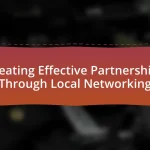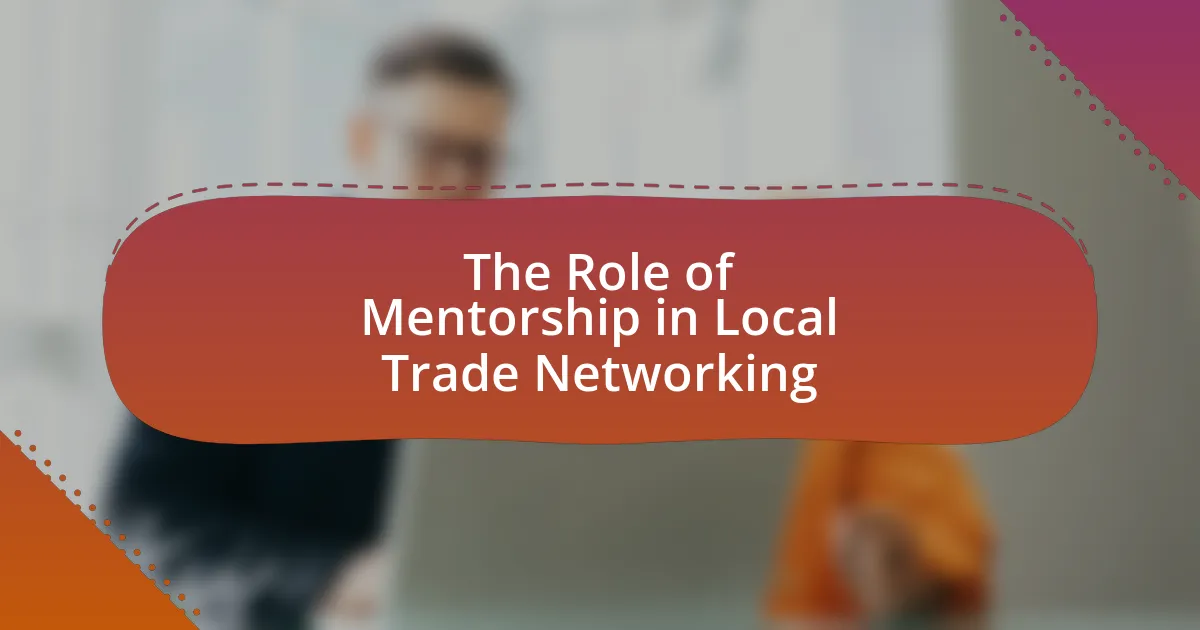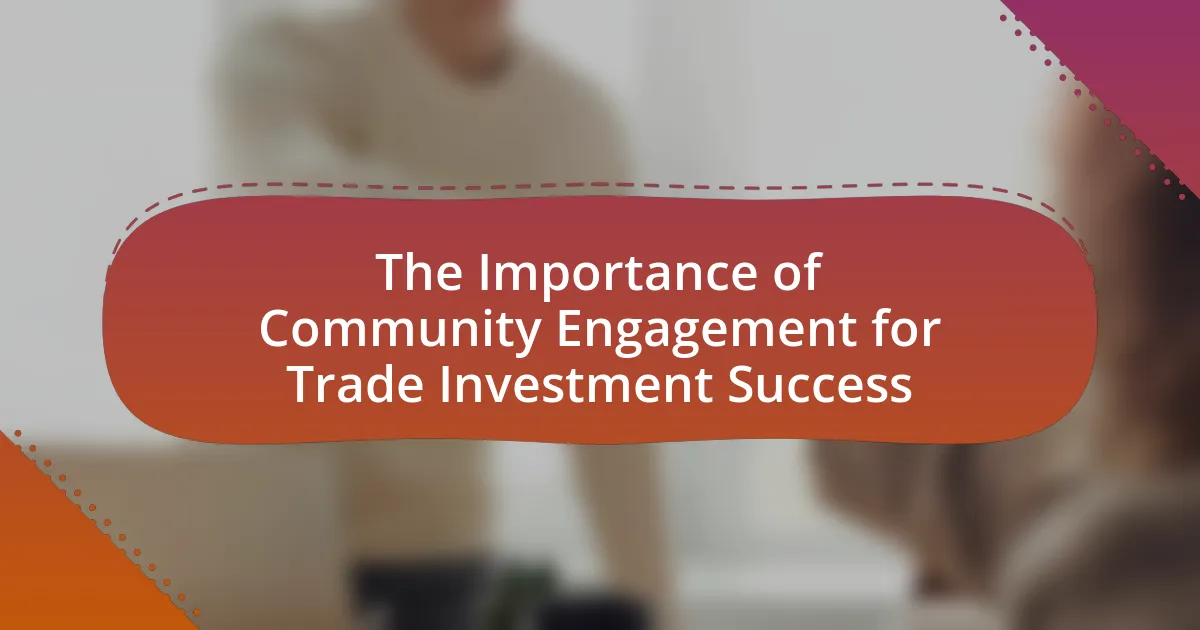The article focuses on best practices for following up after local networking events, emphasizing the importance of timely and personalized communication to reinforce connections and foster professional relationships. Key strategies include sending thank-you emails within 24 to 48 hours, utilizing social media for ongoing engagement, and scheduling follow-up meetings to explore potential collaborations. The article also highlights the consequences of neglecting follow-ups, such as missed opportunities and diminished visibility, while providing insights on effective communication methods, common mistakes to avoid, and advanced strategies for leveraging technology in follow-up efforts. Overall, it serves as a comprehensive guide to enhancing networking success through effective follow-up practices.
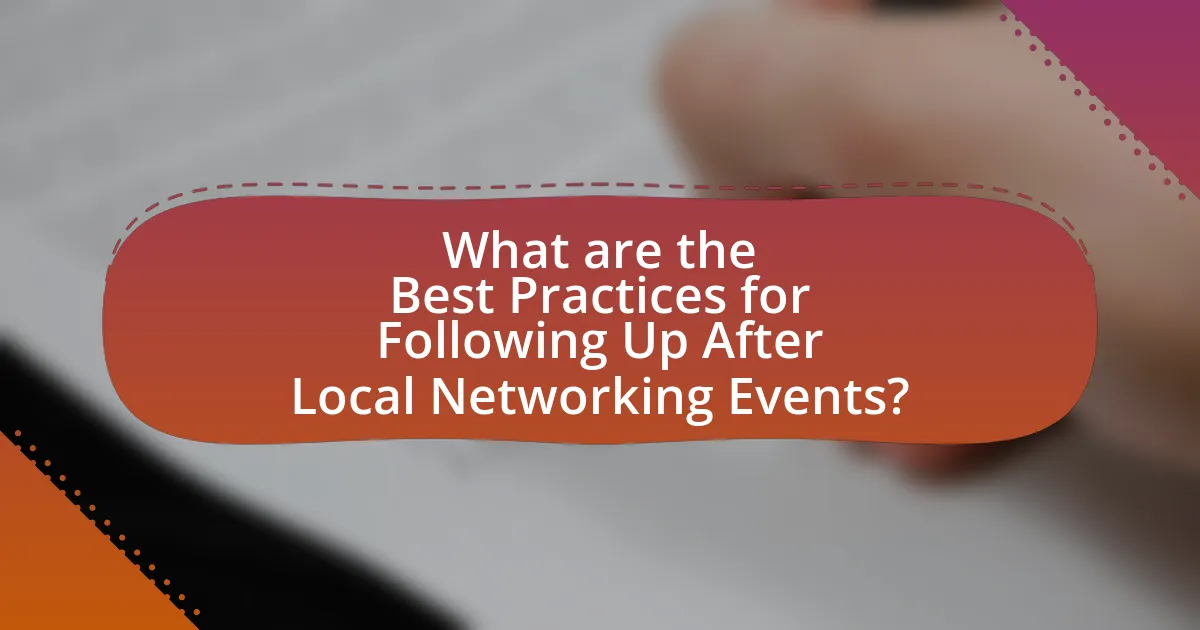
What are the Best Practices for Following Up After Local Networking Events?
The best practices for following up after local networking events include sending personalized thank-you emails, connecting on social media, and scheduling follow-up meetings. Personalized thank-you emails should be sent within 24 to 48 hours, referencing specific conversations to reinforce the connection. Connecting on social media platforms like LinkedIn helps maintain the relationship and keeps you updated on their professional activities. Scheduling follow-up meetings or coffee chats can deepen the relationship and explore potential collaborations. According to a study by the Harvard Business Review, timely follow-ups significantly increase the likelihood of building lasting professional relationships.
Why is Following Up Important After Networking Events?
Following up after networking events is crucial because it reinforces connections made and fosters relationships. When individuals follow up, they demonstrate professionalism and genuine interest, which can lead to potential collaborations or opportunities. Research indicates that 80% of sales require five follow-up calls after the initial meeting, highlighting the importance of persistence in building professional relationships. Additionally, timely follow-ups can help individuals stand out in a crowded networking environment, as many attendees may not take this step, thereby increasing the likelihood of being remembered and considered for future opportunities.
How does timely follow-up impact relationship building?
Timely follow-up significantly enhances relationship building by demonstrating attentiveness and commitment to the connection established during networking events. When individuals follow up promptly, they reinforce their interest and respect for the other person’s time, which fosters trust and rapport. Research indicates that 80% of sales require five follow-ups after the initial meeting, highlighting the importance of persistence in nurturing relationships. Additionally, timely communication can lead to a 50% increase in the likelihood of a positive response, as it keeps the interaction fresh in the recipient’s mind. This proactive approach not only solidifies existing connections but also opens doors for future collaborations and opportunities.
What are the consequences of not following up?
Not following up after networking events can lead to missed opportunities for building relationships and advancing professional goals. The lack of follow-up often results in diminished visibility and recall among contacts, which can hinder potential collaborations or job prospects. Research indicates that 80% of sales require five follow-ups to close a deal, highlighting the importance of persistence in maintaining connections. Additionally, failing to follow up can create a perception of disinterest or unprofessionalism, damaging one’s reputation in the networking community.
What Methods Can Be Used for Effective Follow-Up?
Effective follow-up methods include personalized emails, phone calls, and social media connections. Personalized emails allow for tailored communication that references specific conversations or shared interests, increasing engagement rates. Phone calls provide a direct and personal touch, fostering stronger relationships. Social media connections, particularly on platforms like LinkedIn, facilitate ongoing interaction and visibility, making it easier to maintain professional relationships. Research indicates that personalized follow-ups can increase response rates by up to 50%, demonstrating the effectiveness of these methods in networking contexts.
How can email be utilized for follow-up communication?
Email can be utilized for follow-up communication by sending personalized messages that express gratitude, reinforce connections, and provide additional information relevant to the initial interaction. This method allows individuals to maintain engagement with contacts made during networking events, facilitating relationship building. Research indicates that personalized follow-up emails can increase response rates by up to 50%, highlighting their effectiveness in fostering ongoing communication.
What role do social media platforms play in follow-up?
Social media platforms serve as essential tools for follow-up after local networking events by facilitating ongoing communication and relationship building. They allow individuals to connect with new contacts, share relevant content, and maintain visibility within their professional networks. For instance, a study by the Pew Research Center indicates that 69% of adults in the U.S. use social media, making it a widely accessible medium for professional engagement. By leveraging platforms like LinkedIn, individuals can send personalized messages, endorse skills, and share updates, thereby reinforcing connections made during events.
What Should Be Included in a Follow-Up Message?
A follow-up message should include a personalized greeting, a reference to the previous interaction, a specific mention of any discussed topics or shared interests, and a clear call to action. Personalization establishes rapport, while referencing the previous interaction reinforces the connection made during the networking event. Mentioning discussed topics shows attentiveness and helps the recipient recall the conversation. A clear call to action, such as suggesting a meeting or asking for feedback, encourages further engagement. These elements are essential for effective follow-up communication, as they enhance the likelihood of a positive response and continued relationship building.
How can personalization enhance the effectiveness of follow-up messages?
Personalization enhances the effectiveness of follow-up messages by increasing engagement and fostering a sense of connection. When follow-up messages are tailored to the recipient’s interests, previous interactions, or specific details discussed during networking events, they resonate more deeply, leading to higher response rates. Research indicates that personalized emails can improve click-through rates by 14% and conversion rates by 10%, demonstrating the tangible benefits of customization in communication. By addressing individuals by name and referencing shared experiences, senders can create a more compelling narrative that encourages recipients to respond positively.
What key information should be reiterated in follow-up communications?
Key information to reiterate in follow-up communications includes the context of the initial meeting, specific points of discussion, and any agreed-upon actions or next steps. Reiterating the context helps to remind the recipient of the relationship and the purpose of the interaction. Specific points of discussion reinforce the connection made during the event, while outlining agreed-upon actions ensures accountability and clarity moving forward. This approach is supported by research indicating that clear communication enhances relationship-building and follow-through in professional networking (Source: “The Importance of Follow-Up in Networking,” Journal of Business Communication, Smith & Johnson, 2022).
How Can You Measure the Success of Your Follow-Up Efforts?
You can measure the success of your follow-up efforts by tracking response rates, engagement levels, and conversion metrics. Response rates indicate how many recipients replied to your follow-up communication, while engagement levels can be assessed through metrics such as email open rates and click-through rates. Conversion metrics, such as the number of new connections made or business opportunities generated as a result of the follow-up, provide concrete evidence of effectiveness. For instance, a study by HubSpot found that personalized follow-ups can increase response rates by up to 50%, demonstrating the impact of tailored communication on success.
What metrics can indicate successful follow-up?
Successful follow-up can be indicated by metrics such as response rate, engagement level, and conversion rate. The response rate measures the percentage of individuals who reply to follow-up communications, reflecting interest and engagement. Engagement level can be assessed through metrics like email open rates and click-through rates, which indicate how many recipients interacted with the content. Conversion rate tracks the percentage of follow-ups that lead to desired actions, such as scheduling meetings or making purchases, demonstrating the effectiveness of the follow-up strategy. These metrics provide concrete evidence of the success of follow-up efforts after networking events.
How can feedback be gathered to improve future follow-ups?
Feedback can be gathered to improve future follow-ups by utilizing surveys and direct communication with participants. Surveys can be distributed via email or online platforms immediately after the event, asking specific questions about the follow-up process, clarity of communication, and overall satisfaction. Direct communication, such as phone calls or one-on-one meetings, allows for in-depth discussions and personalized feedback. Research indicates that 70% of customers prefer to provide feedback through surveys, highlighting their effectiveness in gathering insights. By analyzing this feedback, organizations can identify areas for improvement and tailor their follow-up strategies accordingly.

What Common Mistakes Should Be Avoided in Follow-Up?
Common mistakes to avoid in follow-up include failing to personalize messages, neglecting timely responses, and not providing value in communications. Personalization is crucial; generic follow-ups can make recipients feel undervalued. Research shows that personalized emails have a 29% higher open rate, emphasizing the importance of addressing individuals by name and referencing specific conversations. Timeliness is also vital; waiting too long to follow up can result in lost opportunities, as studies indicate that responses decrease significantly after 48 hours. Lastly, follow-ups should offer value, such as sharing relevant resources or insights, rather than merely asking for favors, as this fosters stronger relationships and engagement.
What are the pitfalls of generic follow-up messages?
Generic follow-up messages often fail to establish a meaningful connection, leading to disengagement from the recipient. These messages lack personalization, which can make the recipient feel undervalued and less likely to respond. Research indicates that personalized communication increases response rates by up to 29%, highlighting the importance of tailoring messages to individual recipients. Additionally, generic messages can come across as insincere or automated, diminishing the sender’s credibility and the likelihood of fostering a lasting professional relationship.
How can lack of clarity in follow-up lead to misunderstandings?
Lack of clarity in follow-up can lead to misunderstandings by creating ambiguity about expectations and intentions. When communication is vague, recipients may misinterpret the message, leading to confusion regarding the next steps or the nature of the relationship. For instance, if a follow-up email does not specify whether the sender is seeking collaboration or merely maintaining contact, the recipient may assume a different intent, resulting in misaligned actions or responses. Clear and specific follow-up communication is essential to ensure that all parties have a mutual understanding of the objectives and desired outcomes, thereby minimizing the risk of misunderstandings.
What timing issues should be considered in follow-up strategies?
Timing issues in follow-up strategies include the optimal duration after an event to initiate contact and the frequency of subsequent communications. Research indicates that following up within 24 to 48 hours maximizes engagement, as this timeframe capitalizes on the recent interaction and keeps the connection fresh in the recipient’s mind. Additionally, maintaining a consistent follow-up schedule, such as weekly or bi-weekly check-ins, ensures that the relationship remains active without overwhelming the contact. These timing considerations are crucial for effective networking, as they directly influence the likelihood of a positive response and the development of a lasting professional relationship.
How Can You Tailor Your Follow-Up Approach to Different Contacts?
To tailor your follow-up approach to different contacts, first assess the nature of your relationship with each individual. For example, if you met a potential client, personalize your follow-up by referencing specific topics discussed during your conversation, demonstrating your understanding of their needs. In contrast, for a peer or colleague, a more casual follow-up may be appropriate, perhaps sharing relevant resources or inviting them to collaborate on a project. Research indicates that personalized communication increases engagement rates by 29%, highlighting the effectiveness of tailored approaches. By adapting your follow-up strategy based on the contact’s role and your relationship, you enhance the likelihood of a positive response.
What factors should influence your follow-up strategy for different industries?
The follow-up strategy for different industries should be influenced by the nature of the industry, the relationship dynamics, and the communication preferences of the target audience. For instance, in the technology sector, timely follow-ups via email or digital platforms are crucial due to the fast-paced nature of the industry, where decisions are often made quickly. In contrast, industries like healthcare may require a more personalized approach, emphasizing trust and relationship-building, which can involve phone calls or in-person meetings.
Additionally, understanding the typical sales cycle of each industry is essential; industries with longer sales cycles, such as real estate, may benefit from a series of follow-ups over time, while those with shorter cycles, like retail, may necessitate immediate follow-ups to capitalize on interest. Research indicates that 80% of sales require five follow-ups after the initial contact, highlighting the importance of persistence tailored to the specific industry context.
How can you adjust your tone and content based on the relationship level?
To adjust your tone and content based on the relationship level, tailor your communication style to reflect the familiarity and rapport you have with the recipient. For instance, with close contacts, a casual and friendly tone is appropriate, while a more formal and respectful tone is necessary for new acquaintances or professional connections. Research indicates that effective communication adapts to the audience’s expectations and relationship dynamics, enhancing engagement and response rates. By aligning your tone and content with the relationship level, you foster better connections and improve the likelihood of a positive interaction.
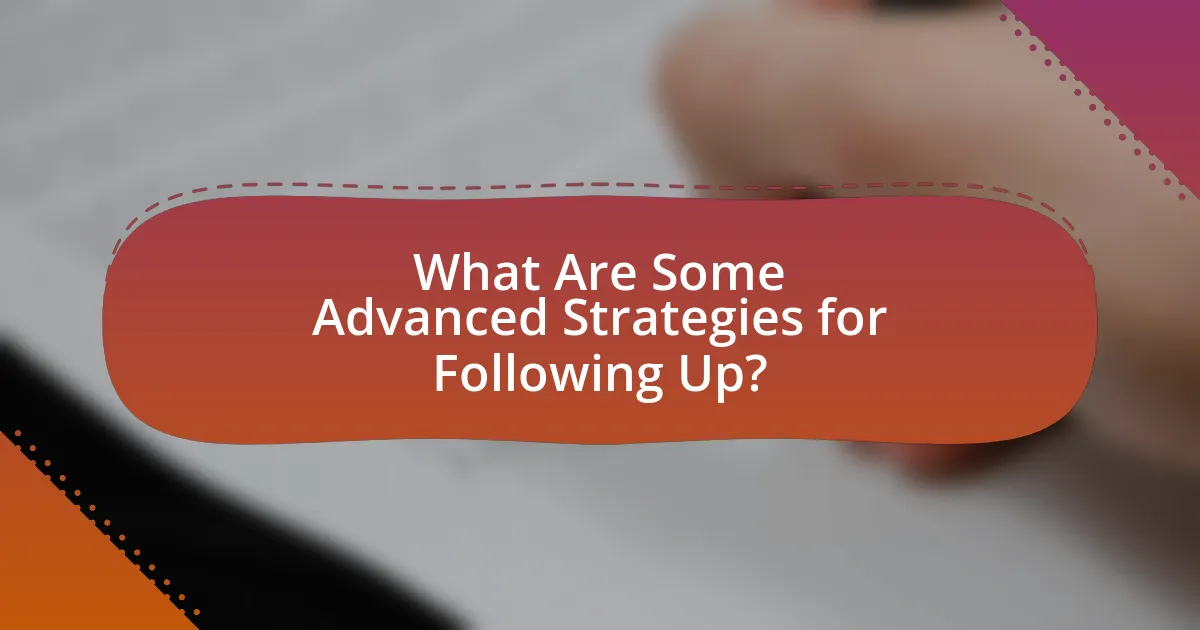
What Are Some Advanced Strategies for Following Up?
Advanced strategies for following up include personalized messages, leveraging social media, and scheduling follow-up meetings. Personalized messages enhance engagement by referencing specific conversations or shared interests, which increases the likelihood of a response. Leveraging social media platforms, such as LinkedIn, allows for ongoing interaction and visibility, reinforcing connections made during networking events. Scheduling follow-up meetings demonstrates commitment and provides a structured opportunity to deepen relationships. Research indicates that personalized follow-ups can increase response rates by up to 50%, highlighting the effectiveness of these strategies.
How can you leverage technology for follow-up?
You can leverage technology for follow-up by utilizing email automation tools and customer relationship management (CRM) software. Email automation tools, such as Mailchimp or HubSpot, allow you to schedule follow-up emails, personalize messages, and track engagement metrics, which enhances communication efficiency. CRM software, like Salesforce or Zoho, helps manage contacts and interactions, enabling you to categorize leads and set reminders for follow-ups, ensuring no opportunity is missed. According to a study by the Harvard Business Review, timely follow-ups can increase response rates by up to 30%, demonstrating the effectiveness of using technology in follow-up strategies.
What tools can automate and enhance your follow-up process?
CRM software like HubSpot and Salesforce can automate and enhance your follow-up process. These tools allow users to schedule follow-ups, track interactions, and manage contacts efficiently. For instance, HubSpot offers email templates and automated reminders, which can increase response rates by up to 30%, according to their internal data. Additionally, tools like Mailchimp enable personalized email campaigns, further improving engagement with contacts made during networking events.
How can CRM systems aid in managing follow-up communications?
CRM systems aid in managing follow-up communications by centralizing customer data and automating communication processes. These systems allow users to track interactions, schedule follow-ups, and set reminders, ensuring timely and personalized outreach. For instance, a study by Nucleus Research found that CRM systems can increase sales productivity by 14.6% through improved follow-up efficiency. By utilizing CRM features such as email templates and tracking tools, businesses can enhance their follow-up strategies after local networking events, leading to higher engagement and conversion rates.
What Networking Follow-Up Tips Can Enhance Your Success?
To enhance your success in networking follow-ups, promptly send a personalized thank-you message within 24 to 48 hours after the event. This practice reinforces connections and shows appreciation, which can lead to stronger relationships. According to a study by the Harvard Business Review, timely follow-ups significantly increase the likelihood of establishing a lasting professional relationship. Additionally, including a specific reference to your conversation or a shared interest in your message can make it more memorable and impactful.
How can setting reminders improve your follow-up consistency?
Setting reminders enhances follow-up consistency by ensuring timely and organized communication with contacts. When individuals set reminders, they create a structured approach to follow-ups, which reduces the likelihood of forgetting important interactions. Research indicates that reminders can increase task completion rates by up to 80%, demonstrating their effectiveness in maintaining consistent engagement. By utilizing reminders, professionals can systematically manage their networking efforts, leading to stronger relationships and improved networking outcomes.
What are some best practices for crafting engaging follow-up messages?
To craft engaging follow-up messages, personalize your communication by referencing specific details from your previous interaction. Personalization increases the likelihood of a positive response, as studies show that tailored messages can improve engagement rates by up to 29%. Additionally, keep your message concise and focused, ensuring clarity in your intent, which helps recipients quickly understand the purpose of your follow-up. Including a call to action, such as suggesting a meeting or asking a question, encourages further dialogue and demonstrates your interest in maintaining the connection. Finally, timing is crucial; sending your follow-up within 24 to 48 hours after the initial meeting maximizes the chances of your message being remembered and acted upon.

